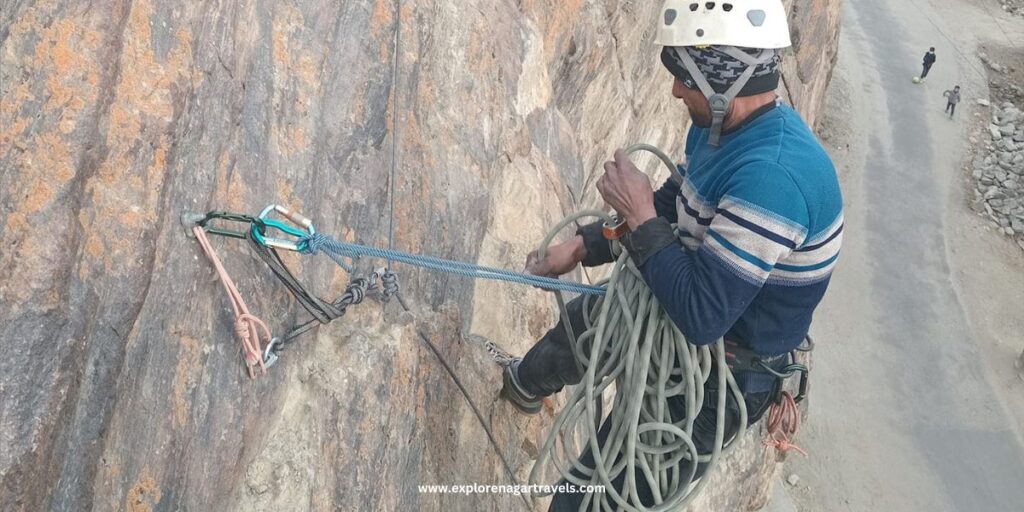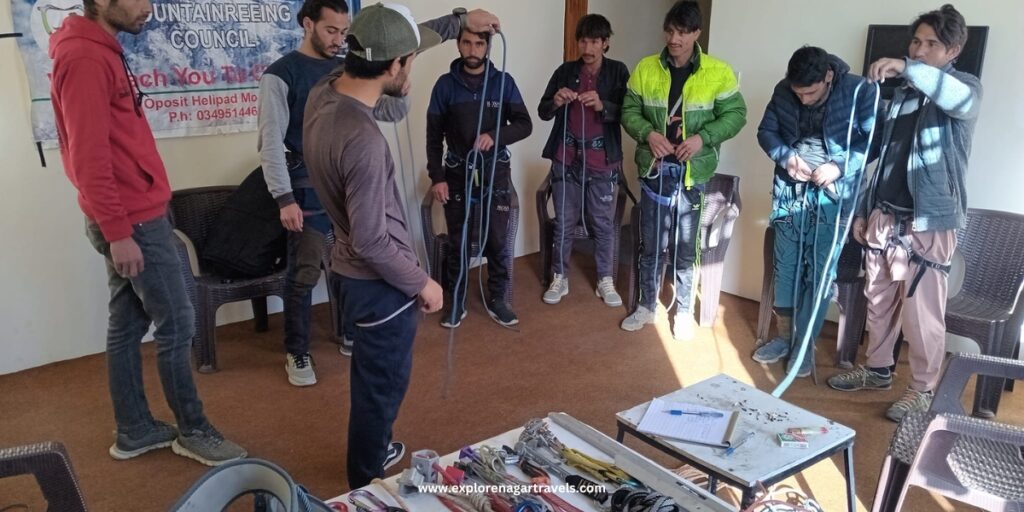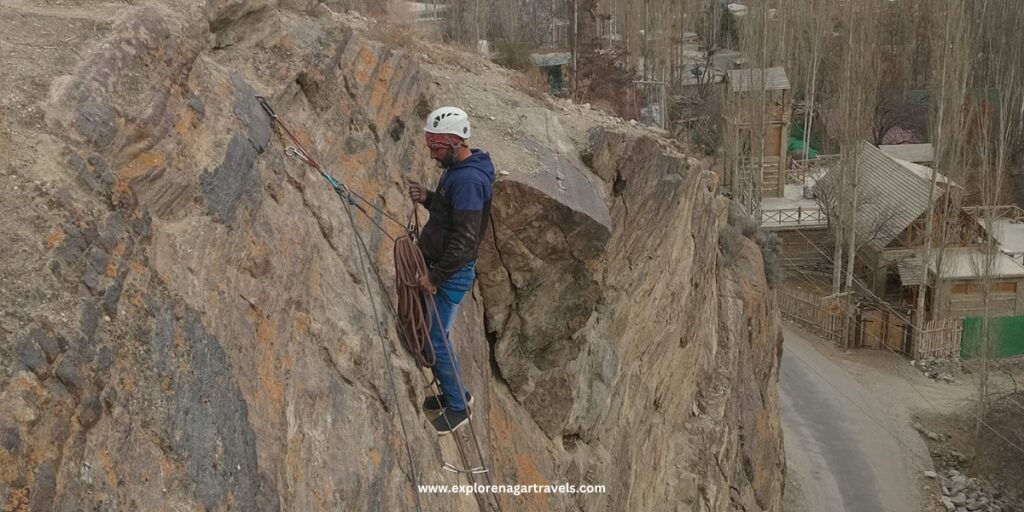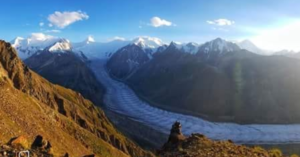Table of Contents
ToggleMountain Climbing in Gilgit-Baltistan
For mountaineers and adventure enthusiasts, the name Gilgit-Baltistan creates a sense of wonder and excitement for the challenge. Gilgit-Baltistan (located among the peaks of Karakoram, Himalaya, and Hindu Kush ranges) boasts some of the world’s highest mountains, making it a dream destination for mountain climbing. This article will highlight the exciting world of mountain climbing in Gilgit-Baltistan. We will explore the opportunities it offers, the challenges to consider, and the essential information for planning your climb. Let’s have a look!
Read More: Famous Dishes of Gilgit-Baltistan
Peaks and Challenges
Gilgit-Baltistan boasts five of the fourteen 8,000-meter peaks, including the mighty K2 (the second highest in the world) and broad peak (the 12th highest). Beyond these giants, various other peaks range from 6,000 to 7,000 meters and offer challenges for climbers of all skill levels.
Gilgit-Baltistan’s Environment
The region presents unique challenges; High altitude, extreme weather conditions, and technical terrain demand proper planning, physical fitness, and a strong sense of teamwork. Acclimatization is crucial to avoid altitude sickness, and climbers should be prepared for rapidly changing weather patterns.
Mountain Climbing in Gilgit-Baltistan
Gilgit-Baltistan isn’t just a climber’s paradise; it’s a playground offering a variety of challenges and experiences for mountaineers of all skill levels. No matter your climbing experience, safety is paramount. Ensure you have the proper training, equipment, and climbing knowledge. Always climb with a partner or a professional guide, especially in remote areas. Here are some opportunities we can explore:

1. Expedition Climbing
The crown jewel of Gilgit-Baltistan’s climbing scene is undoubtedly expedition climbing. This is for the seasoned mountaineers who dream of scaling the world’s highest peaks. Here, you’ll find K2, the savage mountain holding the second-highest title in the world, along with Broad Peak, the twelfth-highest. These expeditions are no small feat. They require meticulous planning that can take months, specialized equipment for high-altitude environments, and a highly skilled support team. The climbs can last for weeks, pushing climbers to their physical and mental limits.
Read More: Best things to do in Skardu Gilgit Baltistan
What to expect?
Technical climbing: Expect challenging terrain with sections of ice climbing, rock climbing, and navigating crevasses.
Extreme conditions: These mountains reside in the “death zone” above 8,000 meters, where the air is thin, temperatures plummet, and the weather can change rapidly.
Logistics and support: Expedition teams typically comprise experienced climbers, high-altitude porters, cooks, and medical personnel to ensure safety and manage logistics throughout the climb.
2. Trekking Peaks
Trekking peaks offer a perfect alternative for those seeking a taste of mountain climbing without the full-blown expedition commitment. These peaks typically range from 5,000 to 6,000 meters, providing a challenging yet achievable objective for experienced trekkers looking to push their limits. The climbs often involve technical sections like snow slopes or glaciers, requiring basic mountaineering skills like crampons and ice axes.
What to expect?
Moderate technical difficulty: Compared to expedition climbs, these involve less technical terrain, but basic mountaineering skills are still necessary.
Acclimatization: Proper acclimatization hikes are crucial to avoid altitude sickness.
Breathtaking scenery: The treks leading to these peaks often traverse stunning valleys, glaciers, and meadows, offering incredible views throughout the climb.
3. Rock Climbing
Beyond the snowy giants, Gilgit-Baltistan boasts a treasure trove of rock-climbing opportunities. Soar up towering granite walls, challenge yourself on dramatic spires, or test your technique on technical crags. The region caters to climbers of all skill levels, from beginners tackling their first multi-pitch climbs to seasoned climbers seeking a new adventure. Popular destinations include the Trango Towers in the Baltoro region, known for their big wall challenges, and the cliffs near Hushe village, offering a variety of routes for all skill levels.

What to expect?
Variety of routes: From beginner-friendly slabs to overhanging technical walls, there’s something for everyone.
Stunning settings: Many climbing areas are located amidst breathtaking scenery, adding to the overall experience.
Local climbing guides: It is highly recommended that you hire a certified local guide familiar with the rock formations and safety protocols.
Read More: Best Places to Visit in Naltar Valley
Essential Steps to Plan Mountain Climbing in Gilgit-Baltistan
Conquering a peak in Gilgit-Baltistan is an adventure that requires meticulous planning and preparation. Here’s a breakdown of the critical steps to ensure a safe and successful climb:
1. Permits and Regulations
Research permit requirements: Climbing different peaks in Gilgit-Baltistan requires specific permits. Research the necessary permits well in advance, considering the peak you plan to climb and the areas you’ll traverse.
Restricted Area Permits (RAPs): Certain regions in Gilgit-Baltistan are restricted due to security concerns. If your climb ventures into these areas, you must obtain restricted area permits (RAPs). The process typically involves applying through the Ministry of Interior and can take several weeks, so plan accordingly.
Local Permits: Additionally, some valleys or villages might have local permit requirements. Check with local authorities or your climbing guide to ensure you have all the necessary permissions.
2. Hiring a Reputable Guide
Venturing into the high mountains of Gilgit-Baltistan, especially for expedition climbs, is not something to take lightly. Hiring a certified local guide is crucial for a safe and successful climb. Here’s why a guide is essential:
Local Expertise
Experienced local guides understand the terrain, weather patterns, and potential hazards specific to the region.
Safety Protocols
They are trained in essential safety protocols for high-altitude climbing, including rope rescue techniques and crevasse crossing.
Logistics Management
Guides can handle logistics like arranging transportation, permits, and communication with local authorities, allowing you to focus on the climb.
Research and recommendations
Research reputable guiding companies in Gilgit-Baltistan. Look for companies with a good safety record and experienced, certified guides. Recommendations from past clients or fellow climbers can be valuable.
Qualifications and certifications
Ensure your chosen guide is qualified for your specific climb. Look for certifications from recognized mountaineering organizations.
Communication and experience
Communicate clearly with your guide about your experience level, expectations, and concerns. Choose a guide with expertise on the chosen peak or similar climbs.
Read More: Things to do in Nagar Valley and Best Places to visit in Hunza and Ghizar Valley
3. Choosing the Right Season
The climbing season in Gilgit-Baltistan is generally between June and September. This is when the weather is relatively stable, with minimal snowfall and clear skies offering better visibility. However, the exact window can vary depending on the specific peak:
Earlier season (June-July)
These months can be ideal for lower altitude climbs, offering comfortable temperatures. However, there might be a higher chance of encountering snow on some higher peaks.
Peak season (July-August)
This is the most popular climbing time, with stable weather and clear skies. However, it can also be the busiest time on popular peaks.
Later season (September)
The weather can become unpredictable in September, with an increased chance of snowfall. However, it can be a good option for experienced climbers seeking a less crowded experience.
4. Training and Equipment
Physical fitness
Mountain climbing is physically demanding. Ensure you are in peak physical condition for the chosen climb. A proper training program focused on endurance, strength, and cardiovascular health is essential.
Mountaineering equipment
Invest in high-quality mountaineering equipment suitable for high-altitude climbing. This includes clothing for extreme weather conditions, crampons, ice axes, ropes, harnesses, and other essential gear. Double-check your equipment to ensure it’s in good working order.
Packing for the climb
Consider your climb’s specific needs and pack light but efficiently. Bring essential items like a first-aid kit, navigation tools, communication devices (with backup batteries), and high-altitude food and hydration supplies.

Have a look at the best honeymoon places to visit in Pakistan
Mountain Climbing in Gilgit-Baltistan Conclusion
Mountain Climbing in Gilgit-Baltistan is more than just a physical challenge; it’s a journey of self-discovery, pushing your limits amidst breathtaking scenery and experiencing the thrill of reaching the coveted summit. Whether you’re a seasoned mountaineer seeking to conquer the giants or an aspiring climber looking for your first taste of mountaineering, Gilgit-Baltistan offers an unforgettable adventure.
So, lace up your boots, train your body, and prepare to be humbled by the majesty of the mountains. With careful planning, the right support team, and a deep respect for the environment, your climb in Gilgit-Baltistan can forever become a story in your memory.
Climbing Opportunities in Gilgit-Baltistan
But wait, there’s more! This article has just scratched the surface of the incredible climbing opportunities in Gilgit-Baltistan. To delve deeper, explore specific climbing routes, discover the unique challenges of each peak, and learn from the experiences of fellow climbers, visit our website’s dedicated section on “Climbing in Gilgit-Baltistan.” There, you’ll find detailed information on various climbs, inspirational stories, and practical tips to make your dream summit a reality.
FAQs About Mountain Climbing in Gilgit-Baltistan
1. What is the best time to go mountain climbing in Gilgit-Baltistan?
The climbing season in Gilgit-Baltistan generally falls between June and September. During this period, you’ll experience relatively stable weather with minimal snowfall and clear skies, offering better climbing visibility. However, the exact window can vary depending on your target peak.
2. Is a guide mandatory for climbing in Gilgit-Baltistan?
A certified local guide is essential for expedition climbs on giants like K2 or Broad Peak. Their expertise in the terrain, weather patterns, and safety protocols is invaluable for a successful and safe climb. While a guide isn’t mandatory for less technical climbs, it’s still highly recommended, especially for navigating unfamiliar areas and ensuring safety.
3. What kind of physical fitness do I need for climbing in Gilgit-Baltistan?
Mountain climbing is a challenging feat. Regardless of your chosen peak, being in top physical condition is crucial. Ensure you have a strong endurance, strength, and cardiovascular health foundation. A dedicated training program focusing on these aspects is highly recommended before climbing.
4. What are some essential things to pack for my climb?
Pack light but efficiently, keeping the specific needs of your climb in mind. Here are some must-haves:
- Mountaineering clothing
Invest in high-quality clothing suitable for extreme weather conditions, including base layers, insulation layers, waterproof shells, and proper footwear.
- Safety gear
Don’t compromise on safety. Pack essentials like a first-aid kit, navigation tools (compass, GPS), communication devices with backup batteries, and a headlamp.
- High-altitude supplies
Stay fueled and hydrated. Pack enough high-calorie food and drinks specifically formulated for high-altitude climbing.
5. Are there any permits required for climbing in Gilgit-Baltistan?
Yes, climbing permits are necessary. The specific permits depend on the peak you plan to climb and the areas you’ll be traversing. Research permit requirements well in advance, including obtaining Restricted Area Permits (RAPs) if your climb ventures into those zones. Additionally, some valleys or villages might have their local permit requirements.







